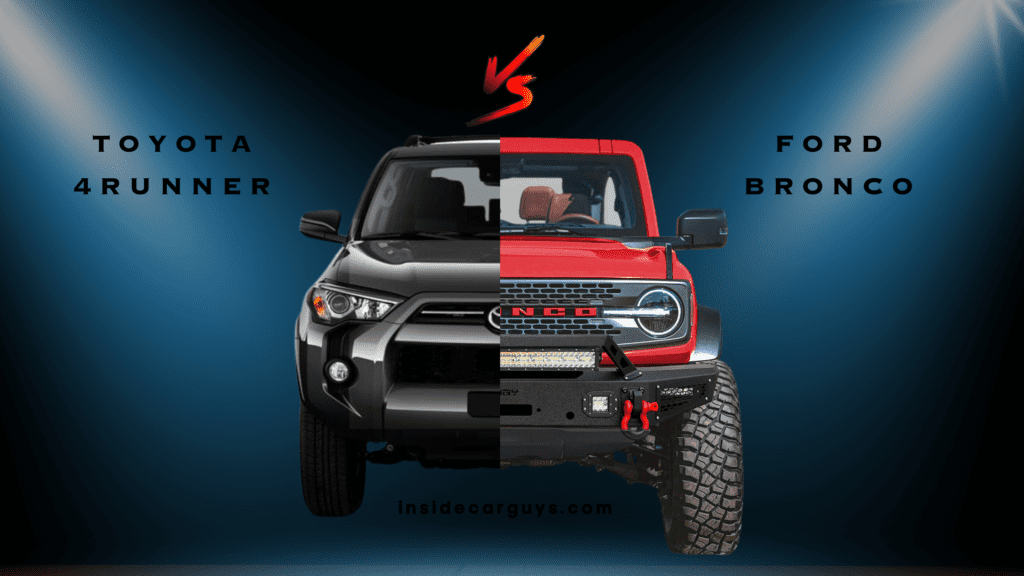In the ever-evolving world of SUVs, the 2023 Toyota 4Runner and Ford Bronco stand out as two rugged and capable options for those seeking adventure and versatility. Both vehicles boast their own unique charm, with the 4Runner maintaining its traditional body-on-frame construction and the Bronco making a triumphant return with its retro-modern design.
This article delves into the characteristics and features of these two SUVs, highlighting their key differences and helping you make an informed decision.
Exterior Design:
The Toyota 4Runner and Ford Bronco both offer rugged and aggressive exterior designs that appeal to those who love adventure and the great outdoors. The 4Runner carries on with its traditional body-on-frame construction and angular lines, while the Bronco offers a retro-modern design that harkens back to its classic roots.
The 4Runner features a bold front fascia with a large grille, flanked by sleek LED headlights. The Bronco, on the other hand, sports a minimalist grille with the brand’s name proudly displayed and round LED headlights that pay homage to its heritage.
Interior Design:
Inside, both vehicles offer functional and comfortable cabins with a focus on durability and user-friendliness. The 2023 Toyota 4Runner features an updated interior with improved materials, providing a more premium feel than previous generations. The dashboard is thoughtfully laid out, with easy-to-use controls and an 8-inch infotainment touchscreen.
The Ford Bronco’s interior also offers an attractive blend of retro design elements and modern technology. The cabin features a mix of durable materials, including rubber flooring and waterproof surfaces, making it easy to clean after a muddy adventure. Its SYNC 4 infotainment system is housed in a 12-inch touchscreen, offering seamless integration with popular smartphone features.
Seating:
When it comes to seating, the Toyota 4Runner and Ford Bronco offer varying levels of comfort and space. The 4Runner is available with either two or three rows of seating, accommodating up to seven passengers. Its seats are supportive and comfortable, with ample space for adults in both the first and second rows. The optional third row is best suited for children, as legroom is limited.
The Ford Bronco, on the other hand, is available in both two and four-door configurations, with seating for four or five passengers, respectively. Its seats are similarly comfortable and supportive, but the rear seat space is somewhat more confined, particularly in the two-door model.
Storage:
Both the 4Runner and Bronco offer plenty of storage space for your gear and belongings. The 4Runner boasts up to 89.7 cubic feet of cargo space with the rear seats folded, while the Bronco offers up to 77.6 cubic feet in the four-door model and 52.3 cubic feet in the two-door version. Both vehicles come with various storage compartments and clever solutions to help you organize your belongings on the go.
Performance:
Off-road prowess is a key attribute of both the Toyota 4Runner and Ford Bronco. The 2023 4Runner is powered by a 4.0-liter V6 engine, producing 270 horsepower and 278 lb-ft of torque, paired with a 5-speed automatic transmission. Its body-on-frame construction and various off-road features, like the available Multi-Terrain Select system, make it a capable off-road performer.
The Ford Bronco comes with a choice of two engines: a 2.3-liter turbocharged EcoBoost inline-four with 270 horsepower and 310 lb-ft of torque, or a 2.7-liter EcoBoost V6 with 310 horsepower and 400 lb-ft of torque.
Both engines can be paired with either a 7-speed manual or a 10-speed automatic transmission. The Bronco’s off-road capabilities are further enhanced by its available electronic locking differentials, trail control, and high ground clearance.
Fuel Efficiency:
In terms of fuel efficiency, the Toyota 4Runner lags behind the Ford Bronco. The 4Runner’s EPA estimates are 16 mpg city, 19 mpg highway, and 17 mpg combined. The Bronco, on the other hand, offers better fuel economy with the 2.3-liter engine, achieving up to 20 mpg city, 24 mpg highway, and 22 mpg combined. The more powerful 2.7-liter engine delivers slightly lower figures, but still outperforms the 4Runner with 18 mpg city, 23 mpg highway, and 20 mpg combined.
Safety:
Both the 4Runner and Bronco prioritize safety, offering numerous standard and available features to protect their occupants. The Toyota 4Runner comes standard with the Toyota Safety Sense P (TSS-P) suite of driver assistance features, including pre-collision system with pedestrian detection, lane departure alert, automatic high beams, and dynamic radar cruise control. Additionally, the 4Runner has a strong body structure and an array of airbags to ensure occupant safety in the event of a collision.
The Ford Bronco offers a similarly impressive list of safety features with the standard Ford Co-Pilot360 suite, which includes pre-collision assist with automatic emergency braking, blind-spot information system with cross-traffic alert, lane-keeping system, and auto high-beam headlamps. The Bronco also features a strong body structure and numerous airbags to keep passengers safe.
Trim Levels:
Both the Toyota 4Runner and Ford Bronco offer various trim levels to cater to different preferences and budgets. The 2023 4Runner is available in the following trims: SR5, Trail Special Edition, SR5 Premium, TRD Off-Road, TRD Off-Road Premium, Limited, and TRD Pro. Each trim offers a different combination of features and equipment, with the TRD Pro being the most off-road-oriented variant.
The Ford Bronco comes in seven different trim levels: Base, Big Bend, Black Diamond, Outer Banks, Badlands, Wildtrak, and First Edition. Each trim offers a unique blend of features, aesthetics, and off-road capabilities, with the Badlands and Wildtrak trims being particularly well-suited for off-road enthusiasts.
Pricing:
When it comes to pricing, the Toyota 4Runner starts at around $37,000 for the base SR5 model and goes up to around $51,000 for the TRD Pro trim. The Ford Bronco, on the other hand, starts at a slightly lower price point of around $30,000 for the base two-door model and can reach up to around $60,000 for the fully-loaded First Edition trim.
Key Differences:
Seating Configuration and Capacity:
The Toyota 4Runner offers the option of two or three-row seating, accommodating up to seven passengers. The Ford Bronco, on the other hand, is available in two or four-door configurations, with seating for four or five passengers, respectively.
Cargo Space:
The 4Runner boasts up to 89.7 cubic feet of cargo space with the rear seats folded, while the Bronco offers up to 77.6 cubic feet in the four-door model and 52.3 cubic feet in the two-door version.
Engine Options and Performance:
The 4Runner is equipped with a single 4.0-liter V6 engine, while the Ford Bronco offers a choice of two engines: a 2.3-liter turbocharged EcoBoost inline-four or a 2.7-liter EcoBoost V6.
Fuel Efficiency:
The Ford Bronco offers better fuel efficiency compared to the Toyota 4Runner. The Bronco’s 2.3-liter engine achieves up to 20 mpg city, 24 mpg highway, and 22 mpg combined, whereas the 4Runner’s V6 engine delivers 16 mpg city, 19 mpg highway, and 17 mpg combined.
Off-Road Capability:
While both SUVs are highly capable off-road vehicles, the Ford Bronco offers a slightly more advanced off-road package, featuring electronic locking differentials, trail control, and high ground clearance. The Toyota 4Runner, however, still provides a capable off-road experience with its body-on-frame construction and available Multi-Terrain Select system.
Trim Levels and Pricing:
The Toyota 4Runner is available in seven trims, ranging from $37,000 for the base SR5 model to around $51,000 for the TRD Pro trim. The Ford Bronco offers seven different trims as well, starting at around $30,000 for the base two-door model and reaching up to around $60,000 for the fully-loaded First Edition trim.
Final Thoughts
After examining the various aspects of the 2023 Toyota 4Runner and Ford Bronco, it is evident that both SUVs cater to different needs and preferences. The 4Runner is an ideal choice for those who require extra seating capacity, spacious interiors, and a reliable reputation. Meanwhile, the Bronco is a strong contender for those who prioritize fuel efficiency, cutting-edge technology, and distinct retro styling.
Ultimately, the best choice depends on your individual requirements and tastes, as both vehicles have a lot to offer and will undoubtedly provide their respective drivers with a thrilling and enjoyable experience.
Features Breakdown:
2023 Toyota 4Runner Features:
- Exterior Design:
- Angular lines
- Bold front fascia with a large grille
- Sleek LED headlights
- Interior Design:
- Updated interior with improved materials
- Easy-to-use controls
- 8-inch infotainment touchscreen
- Seating:
- Two or three-row seating options
- Accommodates up to seven passengers
- Comfortable and supportive seats
- Storage:
- Up to 89.7 cubic feet of cargo space
- Various storage compartments and solutions
- Performance:
- 4.0-liter V6 engine producing 270 horsepower and 278 lb-ft of torque
- 5-speed automatic transmission
- Body-on-frame construction and off-road features
- Fuel Efficiency:
- EPA estimates: 16 mpg city, 19 mpg highway, and 17 mpg combined
- Safety:
- Toyota Safety Sense P (TSS-P) suite of driver assistance features
- Strong body structure and airbags
- Trim Levels and Pricing:
- Seven trim levels: SR5, Trail Special Edition, SR5 Premium, TRD Off-Road, TRD Off-Road Premium, Limited, and TRD Pro
- Pricing ranges from around $37,000 to $51,000
2023 Ford Bronco Features:
- Exterior Design:
- Retro-modern design
- Minimalist grille with brand name
- Round LED headlights
- Interior Design:
- Blend of retro design elements and modern technology
- Durable materials and waterproof surfaces
- 12-inch SYNC 4 infotainment touchscreen
- Seating:
- Two and four-door configurations
- Accommodates four or five passengers
- Comfortable and supportive seats
- Storage:
- Up to 77.6 cubic feet of cargo space in the four-door model, and 52.3 cubic feet in the two-door version
- Various storage compartments and solutions
- Performance:
- Two engine options: 2.3-liter EcoBoost inline-four (270 horsepower, 310 lb-ft of torque) and 2.7-liter EcoBoost V6 (310 horsepower, 400 lb-ft of torque)
- 7-speed manual or 10-speed automatic transmission
- Advanced off-road features and high ground clearance
- Fuel Efficiency:
- EPA estimates for 2.3-liter engine: 20 mpg city, 24 mpg highway, and 22 mpg combined
- EPA estimates for 2.7-liter engine: 18 mpg city, 23 mpg highway, and 20 mpg combined
- Safety:
- Ford Co-Pilot360 suite of driver assistance features
- Strong body structure and airbags
- Trim Levels and Pricing:
- Seven trim levels: Base, Big Bend, Black Diamond, Outer Banks, Badlands, Wildtrak, and First Edition
- Pricing ranges from around $30,000 to $60,000





